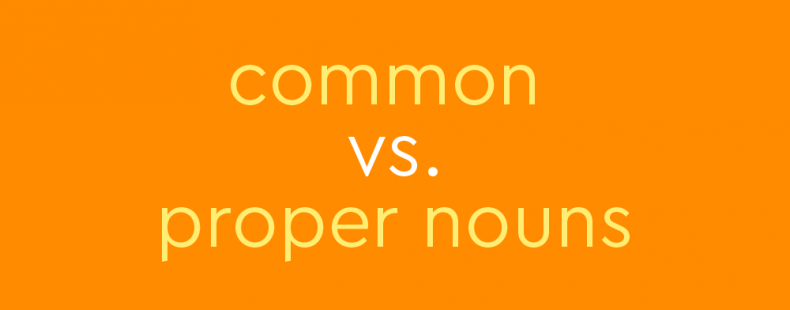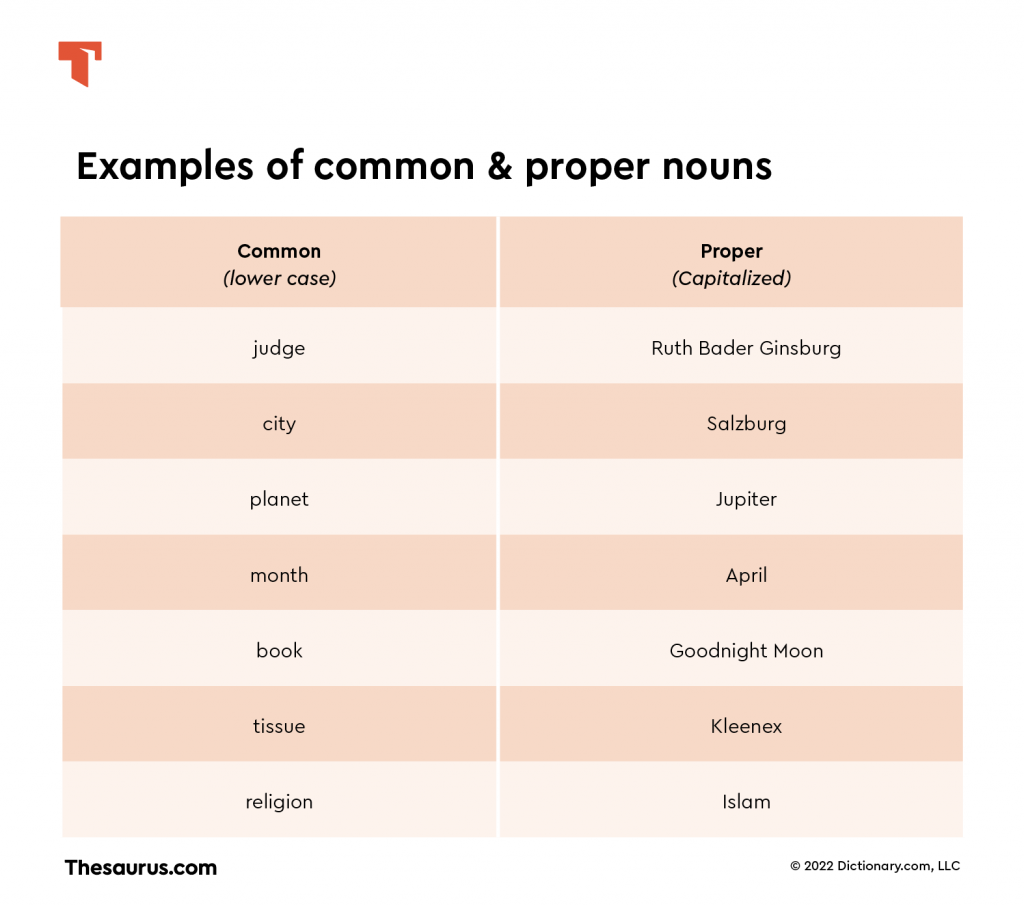A noun is a word that refers to a person, place, thing, or idea. We use nouns to refer to general things like friends or pizza and specific things like Leonardo Da Vinci or Canada. We use a lot of different nouns like these to describe everything around us, but all of the nouns we use can be separated into just two different types: common nouns and proper nouns.
Common noun vs. proper noun
The difference between a common noun and a proper noun is what type of thing they are referring to. Common nouns refer to generic things while proper nouns refer to specific things. For example, the noun country is a common noun because it refers to a general, non-specific place. On the other hand, the noun Spain is a proper noun because it refers to a specific country located in Europe (another proper noun). Grammatically, there is one main difference between common and proper nouns: proper nouns are always capitalized whereas common nouns are only capitalized in very specific situations.
Common nouns
As has been said, common nouns refer to generic people, places, and things. You’ll more easily understand what we mean by this with some examples.
Examples of common nouns
Common nouns can refer to people, places, things, and ideas.
- People: man, woman, child, cop, criminal, butcher, baker, neighbor, friend, enemy, person, stranger, judge, jury, executioner, knights, bishops, kings, queens
- Places: city, town, country, neighborhoods, islands, beaches, province, state, outside, upstairs, basement, hallway, lobby, rooms, alleys, campsites
- Things: guitar, drums, apples, oranges, snow, rain, ice, fire, dirt, cars, trucks, knee, elbows, food, water, sky, stars, day, weeks, month, years
- Ideas, emotions, concepts: happiness, sadness, fear, courage, questions, answers, government, chaos, hunger, confusion, doubt, loneliness, friendship, science
Want a closer look at common nouns? Set your sights on this handy article about them!
Proper nouns
Proper nouns can also refer to people, places, things, and ideas. However, proper nouns refer to more specific people and things.
Examples of proper nouns
As you read each of these proper nouns, you can test your understanding of common nouns. Can you think of a common noun that could also refer to each item referred to by a proper noun?
- People: Harriet Tubman, King Richard the Lionheart, Miles Davis, Emily Dickinson, Helen of Troy, Superman, Lady Gaga, Captain Crunch
- Places: New York City, Moscow, Cairo, Portugal, Zimbabwe, Peru, Europe, Asia, Australia, Main Street, Rocky Mountains, Colorado River, Sahara Desert
- Things: Jupiter, Google, Twitter, Kawasaki Ninja, Playstation 5, Star Wars, Band-aids, Harry Potter and the Chamber of Secrets, Apollo 13, Great Wall of China
- Ideas and Concepts: Christianity, Islam, Buddhism, Romanticism, Cubism, Industrial Revolution, Dark Ages, Monday, November
How do you use common and proper nouns?
Grammatically, the biggest difference between common and proper nouns has to do with capitalization. Proper nouns are always capitalized no matter where they appear in a sentence. One exception to this rule is brand names that use lowercase letters for stylistic reasons: the word iPad is a proper noun even though the first letter is lowercase.
Common nouns, on the other hand, are only capitalized at the beginning of sentences or when used in the title or name of something. For example, the word captain is a common noun and will be lowercase in most sentences. However, it has a capital letter when it is used in a title such as in the name Captain Hook.
Both common and proper nouns are used in most of our sentences. For the most part, it is pretty easy to use them, but you should be careful to always capitalize proper nouns and to only capitalize a common noun when it is appropriate to do so.
Visit the full discussion on proper nouns at our article dedicated to them here.
Tips for differentiating common vs. proper nouns
If you are trying to determine if a word is a common or proper noun, look at the capitalization. Is the noun capitalized in the middle of a sentence? If so, you most likely have a proper noun. Things are trickier if the noun is the first word in the sentence. In that case, ask yourself if the noun is referring to a specific person or thing. If it is, you have a proper noun again. If it isn’t, you are instead looking at a common noun. A good rule of thumb is that all names and titles are proper nouns and will always be capitalized.
Let’s test to see if you have mastered common and proper nouns. Read the following sentences and see if you can figure out if the nouns are common or proper nouns.
- We went to school yesterday.
- We learned about the history of France.
- Jennifer is my older sister.
- She likes to read novels by Stephen King.
Finally, look at these example sentences and see if you can find the three mistakes involving common and proper nouns. (You can find the answers at the end of this article.)
- My favorite American president is theodore roosevelt.
- I like all kinds of animals. dogs are the cutest of them all.
- When we went to Arizona, I took tons of pictures of the Grand canyon.
No more grammar errors
We’ve got a noun for you: genius! And that’s what you’ll be when you check your writing on Thesaurus.com’s Grammar Coach™. This uncommon tool can definitely spot the difference between your proper and common nouns—and more! Grammar Coach™ uses machine learning technology uniquely designed to catch grammar and spelling errors. Its Synonym Swap will find the best nouns, adjectives, and more to help say what you really mean, guiding you toward clearer, stronger, writing.
Whether you’re writing about a person, place, or thing, perfect grammar has never been easier!
Answers: Theodore Roosevelt, Dogs, Grand Canyon
If you want more of a challenge, head over to our quiz on common vs. proper nouns.
















